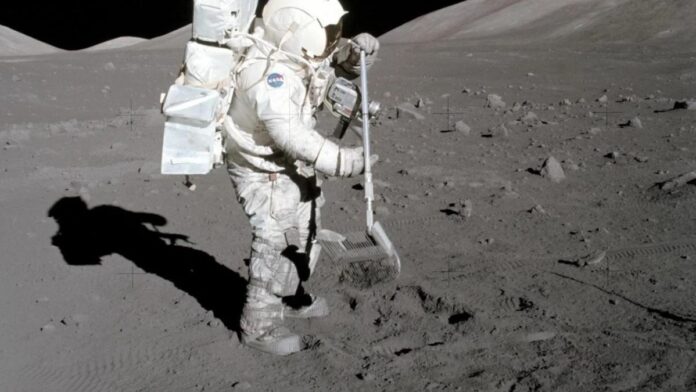NASA’s next moonwalkers may be able to just spray sticky lunar dust away.
A liquid nitrogen spray blasted away more than 98% of simulated moon dust during experiments here on Earth, potentially providing welcome relief to future lunar explorers. The abrasive, fiberglass-like moon dust was a persistent problem during Apollo missions, as it ground away at equipment like lunar rovers.
“Moon dust is electrostatically charged, abrasive and gets everywhere, making it a very difficult substance to deal with,” Ian Wells, lead author of a study reporting the new results and a student at Washington State University, wrote in a statement (opens in new tab). “You end up with a fine layer of dust as a minimum just covering everything.”
Related: How will NASA deal with the moon dust problem for Artemis lunar landings?
NASA landed 12 people on the moon between 1969 and 1972 for excursions of up to three days. The longest moonwalk was about 7.5 hours on Apollo 17 in December 1972, with that mission racking up a record 22 hours and four minutes of spacesuited activities overall.
Even during these short sorties, however, the astronauts found that moon dust got into everything. Brushing at the stuff did little to remove the material, and corrosion on engines, electronics and spacesuit seals was both inconvenient and costly.
Worse, some astronauts got a form of “lunar hay fever” that may have been the early signs of breathing problems like the ones that miners have experienced, Washington State officials said. Coal workers’ pneumoconiosis, also known as “black lung disease,” happens when people inhale coal dust. Over time, the dust scars the lungs and makes it more difficult to breathe, according to the American Lung Association (opens in new tab).
NASA wants to address the dust problem more proactively to help protect its Artemis astronauts, which will start exploring the lunar surface in the mid-2020s, if all goes according to plan. And the Artemis program plans to establish a long-term human presence on the moon, so dealing with dust is probably an even higher priority for NASA now than it was during the Apollo era.
(opens in new tab)
So the new dust-spray tech could really come in handy.
“In their work, the research team demonstrated their technology that uses the Leidenfrost Effect to clean the spacesuits,” Washington State University officials wrote in the statement.
“The effect can be seen when one pours cold water on a hot frying pan, where it beads up and moves across the pan,” they added. “Spray the very cold liquid nitrogen at a warmer dust-covered material, and the dust particles bead up and float away on the nitrogen vapor.”
Study members found that the liquid nitrogen spray was not too abrasive to the spacesuit, yet was still effective at removing dust. Brushing causes damage after just a single session, the study found, while liquid nitrogen required 75 cycles before suit damage happened.
The new research, which was supported by a NASA grant, was published in the journal Acta Astronautica (opens in new tab). The tech also got top honors at the agency’s Breakthrough, Innovative and Game-changing (BIG) Idea Challenge (opens in new tab) in 2022. Washington State associate professor Jacob Leachman supervised the undergraduate team.
Next steps for the research, university officials wrote, include “working to fully understand and model the complex interactions between the dust particles and liquid nitrogen that allows the cleaning process to work.” Study members have also applied for a grant to test the technology in simulated lunar gravity, which is one-sixth the gravity of Earth.
Elizabeth Howell is the co-author of “Why Am I Taller (opens in new tab)?” (ECW Press, 2022; with Canadian astronaut Dave Williams), a book about space medicine. Follow her on Twitter @howellspace (opens in new tab). Follow us on Twitter @Spacedotcom (opens in new tab) or Facebook (opens in new tab).

